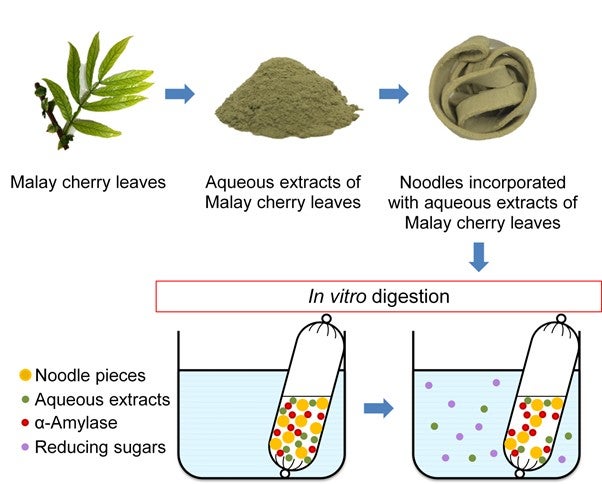Diabetic friendly noodles made from a local plant
HUANG Dejian ((Group Leader, Chemistry) ) June 13, 201713 Jun 2017. NUS food scientists have found that noodles made with extracts from the leaves of the Malay cherry plant are suitable for diabetic patients.
Noodles are a staple food made from dough and consumed around the world. For patients suffering from type 2 diabetes, the noodles available at many local eating places are not suitable for them. Noodles have a high glycemic index (GI), meaning that they are readily digested and absorbed by the body. This raises the blood glucose level and is an issue for people with high blood glucose levels, particularly diabetic patients. NUS food scientists have formulated noodles that digest slowly so that the blood glucose level does not change much. These noodles are made by mixing flour with aqueous extracts from the leaves of the Malay cherry plant, a local edible plant with medicinal properties.
Prof HUANG Dejian and his Ph.D. student Ms ZHANG Yan, both from the Food Science and Technology Programme at the Department of Chemistry, NUS found that they can slow down the digestion of noodles in the body when the noodles are made with extracts from the leaves of the Malay cherry plant. The researchers used aqueous extracts obtained from the cherry leaves and mixed them into wheat, rice, tapioca, and potato flours for this study. In vitro digestion studies of these new types of noodles were carried out under simulated gastrointestinal conditions. The greatest reduction in digestibility was observed in tapioca noodles infused with 8% of the Malay cherry plant extracts after 180 minutes of digestion time. This study shows a practical way to produce starchy foods with low GI. Such foods are highly suitable for people with post-prandial hyperglycemia, a medical condition in which there is a rapid rise in blood glucose levels following a meal.
People with high blood glucose levels (hyperglycemia) are advised to avoid food having a high GI. Such food may lead to a sharp increase in blood glucose levels after consumption. With an increasingly diabetic population, the demand for starchy foods with low GI is also on the rise. Noodles incorporated with strong starch hydrolase inhibitors (aqueous extracts of Malay cherry leaves) tend to slow down the post-prandial glucose release rate. This allows for the digestibility of the noodles to be controlled by adjusting the food formulation. It is a simple way to produce starchy foods with low GI, which are suitable for consumption by the general population, for people with hyperglycemia and those in need of weight control.
This is an initial step towards the development of low GI noodles. Further research might include in vivo studies on the digestibility aspect, and improvement studies on the appearance and textural properties of the cooked noodles. “Malay cherry leaves have shown to be one of the most promising local edible plants in modifying food digestibility and is worthy of further studies to capitalise its potential use as functional food ingredients”, says Prof Huang.

Figure above shows the experimental flow of in vitro digestion of noodles incorporated with aqueous extracts of Malay cherry leaves.
Reference
Zhang Y; Sui X; Huang D*, “Mitigating the in vitro Enzymatic Digestibility of Noodles by Aqueous Extracts of Malay Cherry Leaves”, FOOD CHEMISTRY Volume: 232 Pages: 571-578 Published: 2017.


